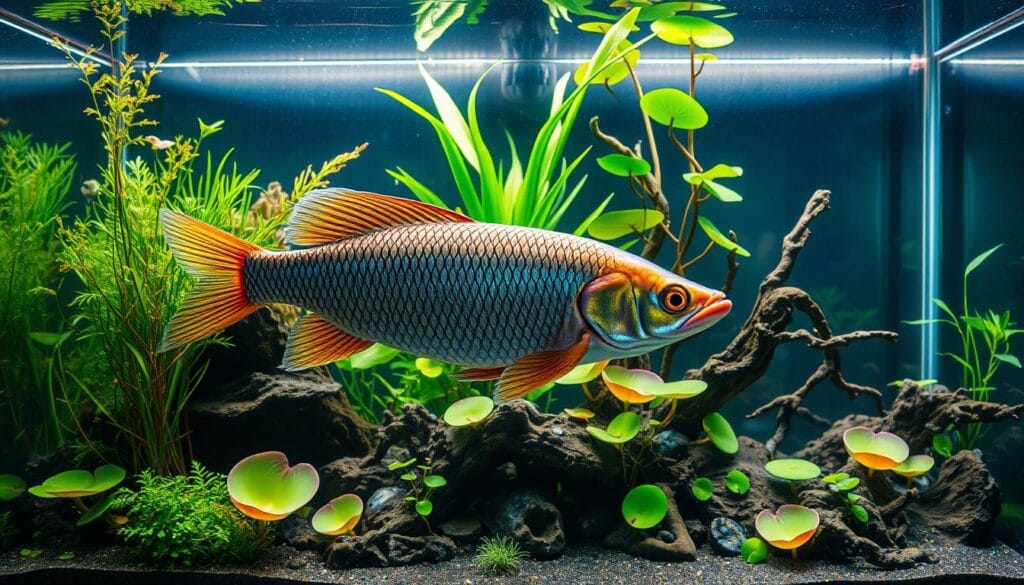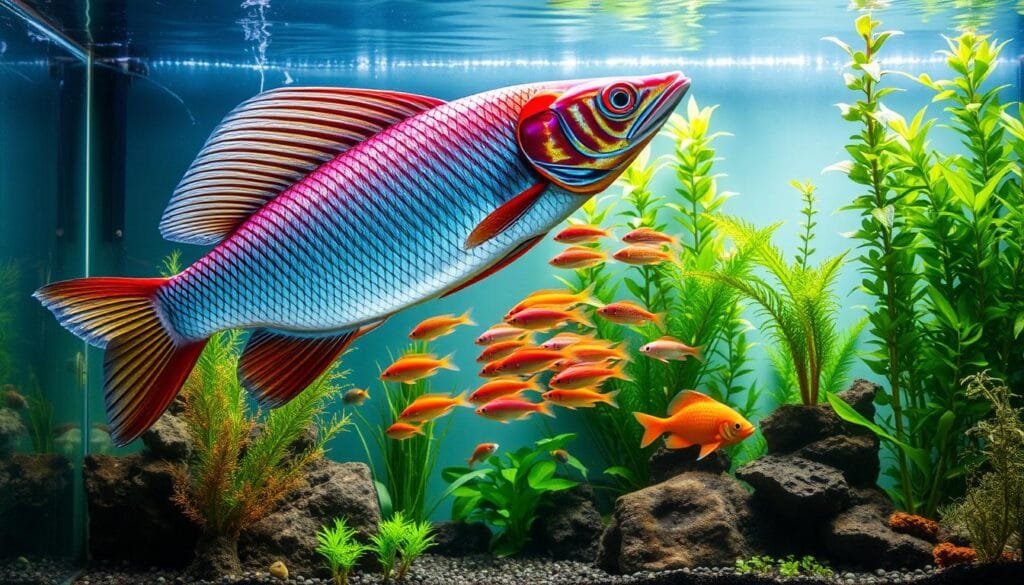My first encounter with an Arowana was unforgettable. Its elegant movement and dragon-like look amazed me. These amazing creatures need more than a simple tank. They need a special aquatic kingdom that meets their unique needs.
Keeping an Arowana is a big commitment. It’s about creating a luxurious underwater home. The size of your tank is key to your fish’s health. Experts say Arowanas need at least 250 gallons of space to live well.
Arowanas are not like other fish. They’re called “dragon fish” for their royal look and special care needs. To create the perfect home, you must understand their specific needs. This includes water quality and enough space to swim.
Table of Contents
Understanding Arowana Species and Varieties
Diving into the world of Arowanas reveals a fascinating array of fish. These majestic creatures are more than just fish – they’re living works of art. They require specialized Arowana tank setup and careful consideration of potential Arowana tank mates.
The Arowana family is diverse, with several notable species. Each variety brings unique characteristics and care requirements. This makes them both challenging and rewarding to keep.
Popular Arowana Varieties
- Silver Arowana: Native to South America, growing up to 3 feet in length
- Asian Arowana: Incredibly rare and highly prized, with stunning color variations
- Jardini Arowana: A robust species typically reaching 2 feet in length
- Banjar Red Arowana: Known for its vibrant red coloration and majestic appearance
Unique Care Needs Per Species
Each Arowana species demands a specific approach to tank setup and maintenance. The Silver Arowana requires a minimum tank size of 250 gallons. The Jardini Arowana can manage in a 180-gallon tank.
Water parameters are crucial – maintaining a pH between 6.5 and 7.5 is essential. Temperatures should range from 75-82°F for their health.
When considering Arowana tank mates, proceed with extreme caution. These fish are notorious for their aggressive nature. They are best suited to solitary environments or carefully selected companion species.
Larger, robust fish might coexist, but careful monitoring is always necessary.
Arowanas are not just fish – they’re living treasures that demand respect, expertise, and dedicated care.
Minimum Tank Size for Arowana
Choosing the right tank size is key for your Arowana’s health and happiness. Silver Arowanas are big and love to swim, so they need lots of space. Knowing what tank size is best will help you create a great home for your fish.
The right tank size depends on a few important things. Adult silver Arowanas can grow up to 3 feet long. This means you need a big tank for them to be happy. Here are some things to think about for your Arowana’s tank:
Tank Size Recommendations
- Minimum tank size: 250-300 gallons for a single adult Arowana
- Recommended tank length: At least 6 feet long to allow adequate swimming space
- Width: Minimum 2-3 feet to provide comfortable movement
- Larger tanks are always better for these active swimmers
Factors Influencing Tank Size
- Fish Growth Rate: Silver Arowanas can grow over an inch in their first year
- Swimming Behavior: They require extensive horizontal swimming space
- Potential Tank Mates: Larger tanks accommodate potential companion fish
- Long-term Fish Development: Consider the Arowana’s potential full-grown size
Your Arowana’s tank should be big. A small tank can cause stress, slow growth, and health problems. A big tank lets your Arowana swim freely and be its best self.
Remember: A happy Arowana is an Arowana with plenty of room to swim!
Filtration Requirements for Arowana Tanks
Keeping the water clean is key for your Arowana’s health. These fish need top-notch filtration to live well in tanks. A good filter keeps them safe and the water stable.
Choosing the right filter is crucial for clean water. High-performance filters are vital for these sensitive fish. They can get sick fast if the water isn’t right.
Types of Filtration Systems
- Mechanical Filtration: Removes solid particles and debris
- Biological Filtration: Processes harmful ammonia and nitrites
- Chemical Filtration: Eliminates dissolved impurities
Recommended Filtration Capacity
Your tank needs a strong filter. Experts say it should filter the tank’s water at least 4 times an hour. For a 250-300 liter tank, you’ll need a filter that can handle 1000-1200 liters per hour.
Key Filtration Considerations
- Choose external canister filters for maximum efficiency
- Ensure gentle water movement
- Conduct weekly water quality tests
- Perform monthly deep cleaning
Investing in quality filtration makes a big difference. Regular care and watching the water closely are essential for your fish’s health.
Aquascaping Your Arowana Tank Requirements

Setting up the perfect Arowana tank needs careful planning and decor thought. Your Arowana needs a place that feels like home, with comfort and safety. The right decor can turn a simple tank into a lively underwater world.
Selecting the Right Substrates
When setting up your Arowana tank, pick substrates that are soft on your fish’s skin. Smooth gravel or fine sand is best. Stay away from sharp materials that could hurt your Arowana.
- Smooth river rocks
- Fine-grain sand
- Rounded aquarium gravel
Creating Strategic Hiding Spots
Arowanas love places to hide. Use driftwood and big, smooth rocks to make hiding spots. These spots help reduce stress and add beauty to your tank.
“A well-designed tank is more than decoration—it’s a habitat that supports your Arowana’s physical and psychological well-being.”
Selecting Appropriate Aquatic Plants
Pick strong plants that can handle an Arowana’s swimming. Tall plants like Amazon swords or Java ferns are great. They look good and help clean the water and add oxygen.
Make sure there’s enough room for your Arowana to swim. A well-set-up tank means a happy, healthy fish friend.
Temperature and Water Conditions
Keeping the water right is key for your Arowana’s health. These fish need the perfect environment to live well in your tank. Knowing about Arowana tank temperature and water quality is very important.
Ideal Water Temperature for Arowanas
The water temperature is very important for your Arowana’s health. It’s best to keep the water between 75 to 86 degrees Fahrenheit. The sweet spot is 82 degrees.
Big changes in temperature can stress your fish. This can weaken their immune system. A good aquarium heater keeps the water stable.
- Optimal temperature range: 75-86°F
- Ideal temperature: 82°F
- Use digital thermometers for accurate readings
pH Levels and Water Hardness
Water quality is also key for your Arowana. They like slightly acidic water, with a pH between 6.0 and 7.5. The water hardness should be 5-16 dKH. This helps them feel at home.
Testing the water often is important. It helps catch any problems early. You can read more about water testing here.
Monitoring Water Parameters
It’s important to check the water often. Use good test kits to check:
- Temperature stability
- pH levels
- Water hardness
- Ammonia and nitrite concentrations
Testing every week and fixing any issues quickly keeps your tank healthy. This is good for your Arowana.
Tank Mates for Arowana

Choosing the right tank mates for your Arowana is key. These fish are territorial, making a peaceful tank setup hard. Over 90% of Arowanas in captivity live alone because of their aggressive nature.
When picking tank mates for Arowanas, consider a few important factors. This will help keep your aquarium peaceful.
Compatible Fish Species
The best friends for Arowanas are large, calm fish. Some good choices include:
- Tiger Datnoid
- Blood Parrot Fish
- Clown Loach
- Large Plecos
- Bichir fish
Fish to Avoid
Stay away from fish that might cause trouble in an Arowana tank:
- Small fish that might be seen as prey
- Overly aggressive species
- Territorial bottom-dwellers
- Fish smaller than 6 inches in length
Social Behavior Considerations
Arowanas are highly territorial fish. They need a lot of space. When setting up your tank, make sure to:
- Use a large tank
- Provide visual barriers
- Ensure enough swimming space
- Keep water parameters consistent
Remember, compatibility depends on the fish’s personality. Always watch your Arowana’s behavior when introducing new tank mates. This helps avoid conflicts.
Feeding Your Arowana
Keeping your Arowana healthy starts with understanding its unique dietary needs. These magnificent fish need a carefully planned feeding schedule. This is to keep them healthy and vibrant.
Dietary Needs and Preferences
Arowanas are natural predators with specific nutritional needs. Their diet should mimic their wild eating habits. They need protein-rich foods to support their high metabolism and growth.
- Protein content is crucial for muscle development
- Diet impacts overall health and color vibrancy
- Varied nutrition prevents dietary deficiencies
Best Food Choices
Your Arowana tank maintenance depends on the right nutrition. Recommended food options include:
- Live foods: Small fish, insects, and crustaceans
- Frozen protein sources
- High-quality commercial Arowana pellets
- Specialized Arowana nutrition sticks
Feeding Schedule
Establishing a consistent feeding routine is key for Arowana health. Here’s a recommended approach based on fish size:
- Small Arowanas (under 6 inches): 3 times daily
- Medium Arowanas (6-14 inches): 2 times daily
- Large Arowanas (over 14 inches): 1-2 times daily
Pro tip: Feed only what your Arowana can consume in 5 minutes to prevent water quality issues.
Careful attention to your Arowana tank feeding schedule is crucial. It ensures a healthy, thriving fish with stunning coloration and a robust immune system.
Maintenance Routine for Arowana Tanks
To keep your Arowana tank perfect, you need a solid maintenance plan. Regular care keeps the water quality high and stops health problems in your fish.
Weekly Maintenance Tasks
Being consistent is crucial for an Arowana tank. Your weekly tasks should cover important areas:
- Perform 20-30% water changes
- Test water parameters
- Clean tank surfaces and decorations
- Check equipment functionality
Detailed Water Change Protocol
Water changes are key for good water quality. Here’s how to do it right:
- Use a gravel vacuum to remove debris
- Replace 20-30% of tank water
- Ensure replacement water matches tank temperature
- Treat new water with a water conditioner
Equipment Maintenance Checklist
| Equipment | Maintenance Frequency | Key Actions |
|---|---|---|
| Filters | Monthly | Clean/replace filter media |
| Heaters | Quarterly | Check temperature accuracy |
| UV Sterilizers | Every 6 months | Replace UV bulbs |
Pro Tip: Consistent maintenance prevents 90% of potential Arowana health issues.
By sticking to regular maintenance, you’ll create a great home for your Arowana. This could help it live over 20 years.
Common Arowana Health Issues
Keeping the water in your Arowana tank clean is key to avoiding health problems. Black Arowanas are very sensitive to changes in their environment. So, it’s important to watch for signs of illness early.
These signs include being very tired, swimming differently, or eating less. These could mean there’s a health issue.
Your Arowana’s health depends a lot on how well you take care of its tank. Diseases like Ich, fin rot, and mouth fungus can come from bad water. Changing the water regularly (10-20% each week) and using strong filters can help a lot.
Also, make sure the water temperature is right. It should be between 75°F and 86°F. This helps your fish stay healthy.
Some health problems to watch out for include drop eye syndrome and gill curling. These can happen from eating too much fat or not having enough space. Giving your Arowana a balanced diet and enough room is important.
If your fish keeps showing symptoms or acts differently, see a vet who knows about exotic fish. They can help figure out and fix health issues early.
Preventing health problems is always better than treating them. Keep the water stable, feed your Arowana well, and make its environment like its natural home. This way, your fish can live up to 20 years in good health.

